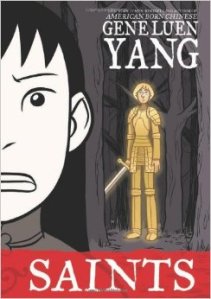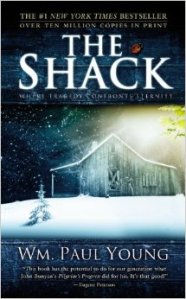 After watching the film, The Painted Veil, my interest has been piqued by the Boxer Rebellion era of China’s vast history. Really, “empire” is a concept that both astounds me and invokes my curiosity. So when I saw Gene Luen Yang’s, Saints, I couldn’t resist giving it a read. Focusing on the time just before the Boxer Rebellion breaks out, a young woman leaves home and winds up becoming a Christian. Ultimately this gets her into some trouble with her family and countrymen and she must make a decision to either join the rebellion, or remain faithful to her beliefs.
After watching the film, The Painted Veil, my interest has been piqued by the Boxer Rebellion era of China’s vast history. Really, “empire” is a concept that both astounds me and invokes my curiosity. So when I saw Gene Luen Yang’s, Saints, I couldn’t resist giving it a read. Focusing on the time just before the Boxer Rebellion breaks out, a young woman leaves home and winds up becoming a Christian. Ultimately this gets her into some trouble with her family and countrymen and she must make a decision to either join the rebellion, or remain faithful to her beliefs.
It was a quick read, only an hour cover to cover. I must confess, dear reader, that not only did this book catch my attention due to its ties to historical intrigues of mine, but I’m gathering books to teach for a World Literature course. I thought this book would make a good addition to the reading list for several reasons. One, it’s told from the perspective of the Chinese and not the occupiers, and it has a female protagonist. As a bonus, it brings up some religious questions as well, which is perfect for a Christian teacher who teaches in a Christian school. But it left me with quite a few questions. Was she sincere in her baptism? What elements of this story come from Chinese mythology? What are readers supposed to take away from this graphic novel?
I’m okay with being left with questions. I’m postmodern enough to accept that sometimes we have more questions after reading a book than the author is responsible for answering. And sometimes the beauty of a book is that it begs more questions than it answers. But the reverse can also be true. Some books, due to poor writing and no authorial intention, are merely confusing and have no point. Or, the book is more for entertainment and less about the literary merit, resulting in good feelings and not good thoughts. So that’s where I’m at with this book.
I want to say that there’s literary merit because I do believe some of the questions that this book leaves readers with are ripe for using in a classroom setting. Teenagers hate gray areas and this would be a perfect way to have them address some of the issues (regarding gender, religion, and sincerity) that they are struggling with. But, is that just wishful thinking on my part. Because this is the second part of a series (however they are non sequential. More like two halves to a coin rather than links in a chain). So I’m hopping that by reading the other part, Boxers, I might get more of a picture here. Or maybe while I marinate over what I just read, the brilliance of the novel and the questions it creates will solidify my desire to teach it.
I’ll keep you posted.
 description in my head). I understand Young’s decision to describe the Trinity as such, but I’ve come to believe that the Godhead look different to each individual. Just as we all have different relationships with each of the Trinity, so do they represent different things to each individual and, thus, look different to each one of us.
description in my head). I understand Young’s decision to describe the Trinity as such, but I’ve come to believe that the Godhead look different to each individual. Just as we all have different relationships with each of the Trinity, so do they represent different things to each individual and, thus, look different to each one of us. rom home has made her a foreigner in her own country. While she was adapting to life in Europe, her generation was adapting to life under the conservative Islamic regime. She comes home greeted by a way of life that is foreign to her.
rom home has made her a foreigner in her own country. While she was adapting to life in Europe, her generation was adapting to life under the conservative Islamic regime. She comes home greeted by a way of life that is foreign to her. to Satrapi’s ability to take a story with so many layers and keep it moving forward and organized while adding her own wit and sarcasm to it. I honestly started reading and lost myself in the story and time in general.
to Satrapi’s ability to take a story with so many layers and keep it moving forward and organized while adding her own wit and sarcasm to it. I honestly started reading and lost myself in the story and time in general.